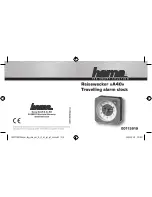
conjunction with, or in place of, the electronic 2-n-1 psycho siren. The connections
for this output is on pages 18 and 19.
Page - 5
Power Doorlock Port:
The AL-1610-EDP is equipped with Omega’s
standard means of interfacing with the vehicle’s power door locking system. This
is via the Omega “DLS” port, which can accept all Omega analog doorlocking
accessories (dual, triple relay sockets, or the modular clip-on add-on relay packs)
and direct-wire basic 3-wire Negative pulse doorlocking systems. All Omega
doorlocking data bus module accessories can be driven by either this port, as well
as D2D via the Data Port.
The DLS port offers two unlocking outputs, so that driver’s door priority
unlocking can be configured. The internal relay options are lock and unlock only.
Remote Start Relay Capability & Satellite Port:
The AL-1610-
EDP features 4 dedicated, built-in high-amperage relays; one of these is even
programmable. And there are two further forms of additional remote starting output
capability- a plug-in port for optional outboard relays (start and ignition operation);
and. See page 28 for specifics.
Auxiliary Sensor Port:
The AL-1610-EDP has a port, for easy plug-in
of the included impact sensor. The port is dual-zoned: the first zone will respond
by chirping the siren only; and the second zone will fully trigger the system. The
included dual-zone impact sensor is packaged with its own instruction sheet, as are
all optional Omega sensors which can be added. The optional plug-in accessory,
AU-EXP, can be used to add 2 more auxiliary sensor ports.
Data Port for OmegaLink & IntelliKit Modules & Bypasses:
Omega’s data bus interface modules and bypass kits simply plug into this port.
These data-to-data (D2D) accessory products save time, and in many cases offer the
only acceptable interface means for many newer vehicle’s doorlocking system and/
or for the OEM-antitheft bypass when adding an alarm or remote starting. Omega
offers the industry’s most comprehensive line of these products (go to
www.caralarm.com for latest application guide), and each includes its own vehicle-
specific instructions.
Only after this is done will the system accept a remote start command, and the vehicle
must remain undisturbed until that point. See the Operation Guide for complete
instructions for remote starting, including Stick Shift Remote Starting.
This feature should only be programmed by the installer, and the operation of
this feature depends on the correct connection of the safety wire to the vehicle’s
parking brake. Please refer to the “Black/White wire” on pages 10 and 11 for the
proper connection of this important wire.
Note: Feature #4, Turbo Timer, and Feature #5, Stick Shift Remote Starting, may
both be used together in the AL-1610-EDP.
Feature #7 Extended Starter Cranking Time
Factory Default Setting
Minimum (.7 Second)
(
press
“arm/lock” button to program
)
Options:
Medium Lo (1.25 Second)
(
press
“disarm/unlock” button to program
)
Medium Hi (1.75 Second)
(
press
“
II
” button to program
)
Maximum (2.5 Second)
(
press
“
III
” button to program
)
Extended Starter Cranking Time operates in conjunction with the previous feature’s
“Tachless” setting. The AL-1610-EDP processor is capable of detecting the running
engine by two separate methods- the use of the vehicle’s tachometer (“tach”) wire
for a direct engine RPM input, or by monitoring the vehicle’s fluctuating voltage
levels caused by the starting process. This feature sets the duration of the starter
output’s base timing for the voltage sensing type of starter output operation. There
are four different base starter output settings. While the default-set minimum is
sufficient for most vehicles; the Extended Starter Cranking
Page - 40
Feature #6 “Tach Wire” or “Tachless” Starter Operation
Factory Default Setting
Tachless (
press
“arm/lock” button to program
)
Option:
Tach Wire (
press
“disarm/unlock” button to program
)
This feature selects the AL-1610-EDP processor’s method of determining the status
of the engine running during remote start operation. As explained in the previous
feature’s description, “Tachless” mode has an associated base starter output time
duration. However, if the voltage fluctuation is detectable, the processor adjusts the
starter output time accordingly. When this feature is set for “Tach Wire” operation,
the base starter output increases to 3 seconds, but the processor adjusts the actual
starter engagement time accordingly. Connecting and use of the “Tach Wire” is the
most reliable form of engine running information input, and its use is recom-
mended. This feature should only be programmed by the installer.
Important: Before this feature is programmed, please refer to the “Violet/White
wire” on page 11 for proper wiring connection, and the Tach Learning Procedure
on page 12.






































